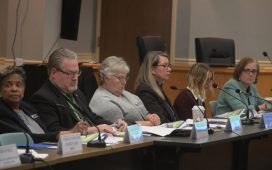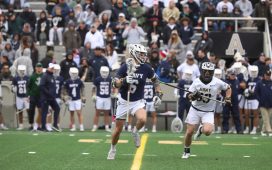The two divisions of the New York Stallion Stakes Series set for Dec. 14 and 15 at Aqueduct are the richest sire stakes races in the country, each featuring $500,000 purses. However, that’s just the start of the money set to be dispersed in the high-dollar races.
The New York Thoroughbred Breeding and Development Fund offers awards to breeders of New York-breds and owners of stallions residing in the state, as well as owners of New York-bred and -sired racehorses who win in open company, and this weekend stands to be one of the most lucrative in the Fund’s history.
As the Empire State’s racing and breeding programs have evolved over the past several decades, the fund has been at the forefront of rewarding the state’s participants and establishing the New York program as one of the most rewarding places to bring up a state-bred. That status took a leap forward over the past decade after the building of Resorts World Casino New York at Aqueduct pumped unprecedented money into incentives on the racetrack and in the breeding shed, to the point where the Fund annually disperses more than $15 million in incentives.
“It’s a great program, and it always has been,” said Joe McMahon, owner of McMahon of Saratoga Thoroughbreds and a longtime board member with the New York Thoroughbred Breeding and Development Fund. “It’s caught on more in the last 10 years than it probably did in the first 30 years, but it certainly is a worthwhile thing. Every state that has a racetrack has got one, and they’re all modeled after this one. New York must be doing something right.”
McMahon has been a member of the Fund’s board for roughly three decades, and his farm has been one of its top earners. Between awards for breeders and stallion owners, McMahon of Saratoga Thoroughbreds brought in $533,737 from the Fund in 2018, helped along greatly by the early success of then-freshman sire Central Banker. The farm has brought in $383,292 from breeder and stallion awards this year through the end of October.
Breeders of a New York-bred and -sired runner that wins at any track in New York earn a bonus equal to 30 percent of a race’s purse, while second- and third-place breeders get a 15 percent bonus. If the horse was born in New York, but by a sire outside of the state, the bonus structure 15 percent to a winning breeder and 7.5 percent for finishing in the money.
Stallion owners receive a bonus of 10 percent on purse earnings through third place at New York tracks, capped at $10,000 per-horse per-race, as long as the runner was also born in the state. Owners of New York-bred and -sired racehorses receive a 20 percent purse bonus up to $20,000 for running first through third, while owners of New York-breds that were conceived elsewhere earn 10 percent for the same placings.
“It’s kept me in business, honestly,” said Chris Bernhard of Hidden Lake Farm in Stillwater, N.Y. “If we didn’t have that, and we were just selling horses, and we didn’t have the annuity on the other side of it, I probably wouldn’t be doing it at the scale that I’m doing it. I’d probably have fewer horses, just higher quality and fewer numbers. It’s keeping me interested in promoting stallions within the state. I’ve got 18 2-year-olds by Bellamy Road in the pipeline as a breeder. If I can get a little bit lucky, that’s a huge chunk of change down the line.”
Bernhard has been increasing his investment in the New York stallion program in recent years, as a partner in Redesdale in 2019 and with Solomini in 2020.
The incentives for investing in stallions has not only helped New York residents grow the program from within, it has led out-of-state owners to retire their star runners within the state, as well.
One of the most notable members of that category is Mission Impazible, a son of Unbridled’s Song who was campaigned by Kentucky-based Twin Creeks Racing Stables and retired to Sequel Stallions New York in Hudson.
Mission Impazible has gone on to become a perennial leading sire in several different categories in his new home state. In doing so, he’s brought in over $500,000 in stallion owner awards during his still-young stallion career. The Twin Creeks operation will attempt to double down on that success with Destin, a multiple Grade 2-winning son of Giant’s Causeway who retired to Sequel New York in 2019.
“It was a good fit because we enjoy racing in New York,” said Twin Creeks’ Randy Gullatt. “The purse structure is excellent, and we wanted to put [Mission Impazible] in a regional market where he was a bigger fish, so it was a perfect fit for us.
“I think it’s one of the best, if not the best breeding incentive programs out there,” he continued. “We took full advantage of having a sire standing there, and having a Kentucky farm and being able to raise them in Kentucky but share that New York program. It’s been very good for us.”
The financial benefits of the Fund are apparent, and the benefit of more and higher-quality horses from the New York-bred program for the state’s racetracks is also clear. However, McMahon said one of the fund’s original purposes had less to do with the horses themselves, but the land they occupy.
“It was designed to keep green space and agriculture,” McMahon said. “It was designed to produce racehorses for the NYRA tracks, so it accomplished all those goals. The agricultural sector is hundreds of thousands of acres in agriculture, most of it in the Hudson Valley, which over the last 40 years, would have been houses.
“The influx of people buying vacation homes and second homes in the Hudson Valley has been tremendous pressure,” he continued. “They’ve been moving out of the cities to do that. They’re an hour and 20 minutes from Manhattan. This has pushed some of that growth up further, which maybe isn’t a bad thing because they need more further north. The program did exactly what it was set out to do, which was to preserve farmland, develop an industry, and create jobs. We see new people getting into it every year. We see farms getting converted into horse farms.”
New to the Paulick Report? Click here to sign up for our daily email newsletter to keep up on this and other stories happening in the Thoroughbred industry.
Copyright © 2019 Paulick Report.








